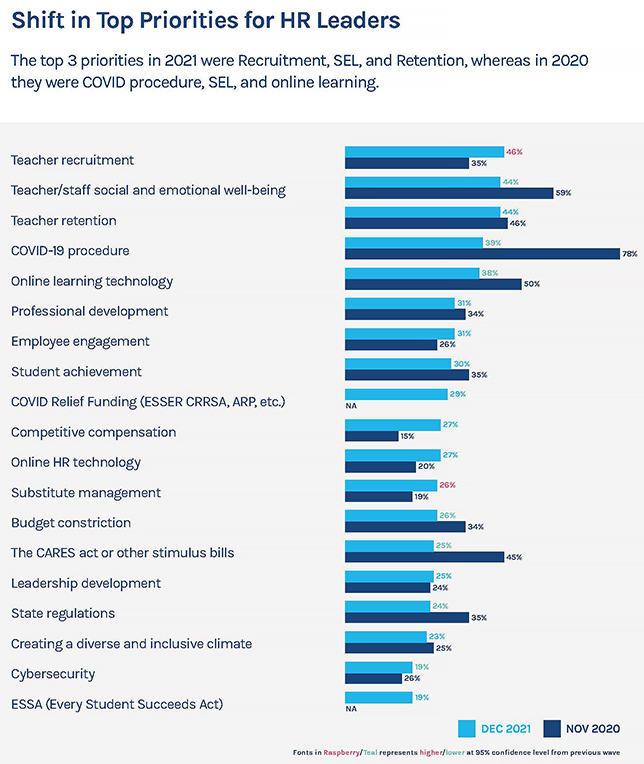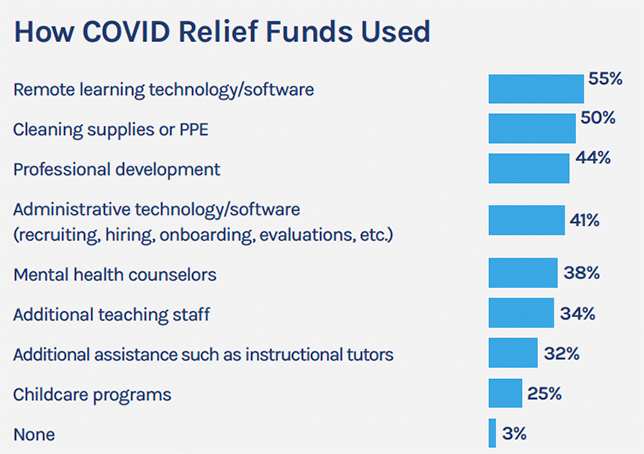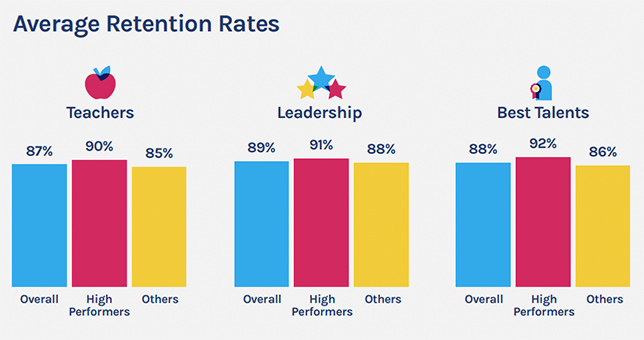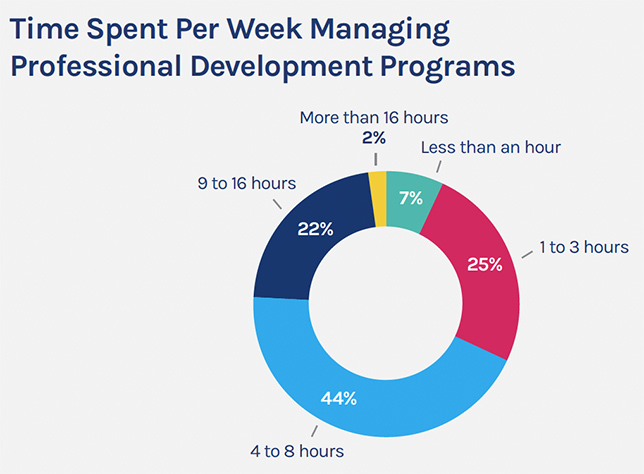HR Priorities Now Led By Teacher Recruitment, Retention, and Support, PowerSchool Study Shows
- By Kristal Kuykendall
- 02/28/22
A new survey of K–12 human resources professionals shows that districts’ top priorities have shifted from COVID-19 procedures and online learning to teacher recruitment, staff well-being, and teacher retention, amid a growing focus on professional development access for teachers and administrative tech solutions.
For PowerSchool’s 2022 K-12 Talent Index Education Research Report, researchers at Strategy Analytics conducted a blind survey of 324 HR professionals at K–12 districts across the country, asking them about their retention and hiring processes, priorities, challenges, and industry trends.
“HR priorities continue to shift significantly this year,” the report summary states. “Retaining teachers, boosting employee morale, and hiring new talent are the top HR challenges. Recruiting has become even more of a priority from last year. Respondents also say teacher morale and retention have the highest impact on their talent operations. While adapting to operational challenges and implementing online learning technology remain in the picture, their dominance has receded over the last year.”
Survey respondents said their top priorities in 2021 were teacher recruitment, staff well-being, and retention; in 2020 the top three were COVID-19 procedure, SEL, and online learning.
Other HR priorities that saw significant increases since 2020 are competitive compensation, substitute management, employee engagement, cybersecurity, and HR technology.

When asked about whether schools are spending COVID-19 relief funds for needs not directly related to the pandemic, 53% of respondents said they were; top non-COVID spending areas included professional development for teachers, administrative technology and software, and hiring mental health counselors.

In addition to reporting survey responses, the researchers conducting the study also identified “high performers” among those districts responding by analyzing key HR performance data in the “four pillar areas of HR management”: onboarding, contracts, retention, and professional development. “After identifying the top-performing organizations from the group of respondents, the researchers then looked for common attributes among their survey responses,” PowerSchool’s report explained. “They found consistent markers that set them apart from other respondents reporting less success in the four pillar areas, including the maturity of their HR technology, process efficiencies, and focus areas.”
According to the researchers, the identified high-performing K–12 organizations in their study held the following common attributes:
Automated Systems: The majority of high-performing organizations surveyed already have automated digital systems for onboarding new employees and renewing contracts.
Integrated Processes: High-performing organizations report integrated processes for position management and workforce planning, contract management, reporting, and analytics.
Data Efficiencies: High performers minimize duplicate data entries, and respondents report that they can find the information they need in five minutes or less. By contrast, the majority of respondents report it can take up to 30 minutes to find the data they need.
Faster, Easier Onboarding and Contracts: Successful onboarding correlates strongly to employee retention in this research. High performers report onboarding new hires in as few as two days, with problems rarely encountered. On the other hand, most organizations indicate it takes up to a week to onboard a new employee, and they experience process-related challenges almost half the time. High performers also report they need less time from their HR staff to manage the onboarding process and contract renewals, with most able to onboard a new employee in about five hours or less. Others report around eight hours.
Data-Driven Decision-Making: High-performing organizations indicate that they use data from various sources to guide decision-making and planning. For example, high performers tend to prioritize the use of past evaluation feedback when building PD plans more than other respondents.
Teacher Retention and Support
Teacher and staff retention rates for this school year reveal the increasing burden on HR professionals of the reported rise in teacher burnout Only four in 10 say they retained more than 90% of their most valuable talent. Leadership retention is only slightly higher, with half retaining more than 90% of their leadership. Organizations identified as high performers across the pillar performance areas tend to report higher staff retention, the report said.

The survey data also revealed clear connections between high-performers in the four pillar areas of HR and higher retention levels. “High performing organizations feel their processes are highly efficient and that they are proactive rather than reactive,” the report said. “They also spend less time on daily HR processes such as paperwork, finding data, and accessing systems. In short, they free HR staff and administrators to focus more on people and less on processes. ”
Another top priority for respondents, managing professional development programs, “requires a lot of time for districts, with two-thirds spending more than half a day per week and one in four spending more than one full day each week,” the report said. “A small group of high performers has reduced PD management down to less than an hour per week.”

High-performance districts spend less time onboarding new hires, the survey showed, and are able to fill their open positions more quickly.
Overall, 60% of respondents said filling an open teacher position takes more than a month on average; for respondents whose districts perform well in the four pillar areas, the majority (57%) fill roles in a month or less. Onboarding is also faster for high performers: more than three-fourths (77%) of high-performing districts report that onboarding new hires is completed in five days or less, and 70% of high performers use automated onboarding checklists and forms.
Respondents also listed their HR priorities for the next year:
- Correlating teacher growth with student achievement
- Digital records and contracts
- Think past evaluation feedback is extremely important for defining Professional Development plans
“Stronger performers are also more likely to prioritize PD, in addition to efficiency improvements like digital records and contracts,” the report said. “One trend the researchers noted is schools and districts looking at teacher growth along with student achievement, and then integrating past evaluation feedback into future PD plans. This is just one example of combining data from classrooms and HR records to inform decision-making.”
Download the full K-12 Talent Index Education Research Report, at the PowerSchool website.
About the Author
Kristal Kuykendall is editor, 1105 Media Education Group. She can
be reached at [email protected].